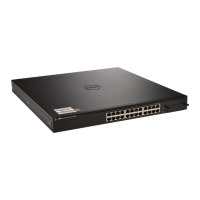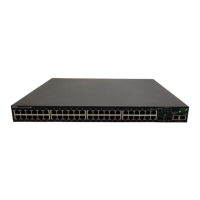Switch Features 63
• Dynamic ARP Inspection: By default, if Dynamic ARP Inspection packets
are received on a port at a rate that exceeds 15 pps for 1 second, the port
will be diagnostically disabled. The threshold is configurable up to 300 pps
and the burst is configurable up to 15s long using the
ip arp
inspection limit
command.
A port that is diagnostically disabled due to exceeding one of the above limits
may be returned to service using the no shut command.
Captive Portal
The Captive Portal feature blocks clients from accessing the network until
user verification has been established. When a user attempts to connect to
the network through the switch, the user is presented with a customized Web
page that might contain username and password fields or the acceptable use
policy. You can require users to be authenticated by a local or remote RADIUS
database before access is granted.
For information about configuring the Captive Portal features, see
"Configuring Captive Portal" on page 413.
Dot1x Authentication (IEEE 802.1X)
Dot1x authentication enables the authentication of system users through a
local internal server or an external server. Only authenticated and approved
system users can transmit and receive data. Supplicants are authenticated
using the Extensible Authentication Protocol (EAP). PEAP, EAP-TTL, EAP-
TTLS, and EAP-TLS are supported for remote authentication servers. Local
(IAS) authentication supports EAP-MD5 only.
For information about configuring IEEE 802.1X settings, see "Configuring
Port and System Security" on page 469.
MAC-Based 802.1X Authentication
MAC-based authentication allows multiple supplicants connected to the
same port to each authenticate individually. For example, a system attached
to the port might be required to authenticate in order to gain access to the
network, while a VoIP phone might not need to authenticate in order to send
voice traffic through the port.
For information about configuring MAC-based 802.1X authentication, see
"Configuring Port and System Security" on page 469.

